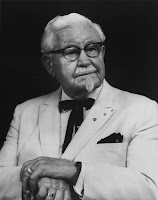VICKS, the leading name in cough , cold flu and pain
medications, began in the 1890s as a concoction of pharmacist Lunsford
Richardson, who developed a menthol-based salve that releases soothing vapors
when applied to the body.
He named it after his brother-in-law, Dr. Joshua W.
Vick, who helped him in setting up his
business. Richardson created 21 products which he sold under his newly- formed
Lunsford Richardson Wholesale Drug Co. in 1898, which became Vick Chemical Co.
In the 1930s, the company merged with William S. Merrell Chemical
Co. to become Richardson-Merrell. In time, VICKS became a successful global
brand, and the products reached our shores after the war, distributed by VICKS
International. The initial products were VICKS Vaporub and Cough Drops.
In the 1950s, VICKS was actively promoted in the
Philippines via Print and Radio advertising. It became a household name when
VICKS started a radio show on DZRH, entitled “Reyna ng Vicks” in which
housewives and mothers recounted their saddest sob stories. The one who could
elicit the most reaction via audience applause, was crowned as “Reyna ng
Vicks”. A film version starring Susan
Roces hit the movie screens in 1958.
After various mergers and acquisitions, it became
Richardson-Vick, Inc., in 1980 . Procter and Gamble (P&G) acquired the
company from the Richardson family and its advertising began in 1987, initiated and managed by the
local P&G office, and which continues to this day.
**********
VICKS VAPORUB. The most popular VICKS product was created
in 1919. During the Spanish flu epidemic in the U.S. in 1919, Vaporub sales
tripled to $2.9 million in just one year. It was th first VICKS product to
become available in the Philippines after the War.
 |
| VICKIE SANTOS, VICKS brand charactre, 1950s. |
**********
VICKS COUGH DROPS. The popular menthol cough drops were
launched in 1931, and were instant hit, selling 25 million pacakges in the
first year. By the 1950s, they were widely available in local drugstores. Flavored versions--Wild Cherry and Lemon-- were made to appeal to kids.
**********
VICKS VA-TRO-NOL. Also introduced in 1931, VICKS Va-tro-nol Nose Drops was launched in
1953 in the Philippines. The drops provided relief from nasal congestion, bit
did not catch on with the Filipino public.
**********
VICKS INHALER. The instant stuffy nose
reliever-in-a-tube, first produced in the U.S. in 1951, was launched in the
Philippines in 1959. Its advertising was the first to use a celebrity, matinee
idol Jaime de la Rosa, as its print model.
**********
VICKS FORMULA 44.
VICKS Cough Syrup, the first liquid cough syrup introduced by Vicks was
launched in 1952. As VICKS Formula 44, the syrup provided 8 hours of
long-lasting relief to cough sufferers.
**********
VICKS IMPACT. The short-lived anti-cold VICKS Impact
tablet for cold and fever was introduced in 1959, but did not flourish.
 |
| VICKS IMPACT, 1959 |
**********
SOURCES:
Information source:
Picture source:
REYNA NG VICKS: Video48, http://video48.blogspot.com/2014/01/the-fifties-503-gloria-romero-rita.html




























